Without proper prevention measures, corrosion and rust can cause metal objects to lose their structural integrity, crack and develop holes. This guide will explore the critical role of corrosion resistance in metal 3D-printed products, offering valuable insights for the manufacturing and engineering sectors. Learn how to improve corrosion resistance in metal 3D-printed enclosures below.
QUICK LINKS
The Importance of Corrosion Resistance in Metal 3D Printing |Types of Corrosion in Metal 3D-Printed Products |How the Metal Manufacturing Industry Gauges Corrosion Resistance | Pioneering Surface Treatments and Their Advantages | Overcoming Corrosion Hurdles in Metal 3D Printing |Balancing Costs With Corrosion Resistance | SPC’s Expert Role in Elevating Corrosion Resistance | Learn More About SPC’s Corrosion-Resistant Plating Solutions Today
The Importance of Corrosion Resistance in Metal 3D Printing
Corrosion is the gradual degradation of a material due to chemical reactions with its surrounding environment.1 While it impacts various materials, like ceramics and polymers, corrosion is most commonly associated with metals.
When a metal product corrodes, it loses electrons and undergoes oxidation.2 As a result, the metal accumulates fine surface rust that is usually red or white in color. In some cases, it can develop more substantial issues like holes, punctures and fractures. Implementing proper corrosion resistance measures is essential to prevent these detrimental effects.

Types of Corrosion in Metal 3D-Printed Products
Several forms of corrosion can affect metal products, such as:
- General or uniform corrosion: Uniform corrosion gradually spreads over the metal’s entire surface.3 It commonly affects exposed ferrous metals and alloys not protected by surface coatings or cathodic protection. Uniform corrosion slowly causes the metal to deteriorate, growing more brittle over time and eventually breaking.
- Pitting corrosion: Pitting is more localized, severe concentration in a specific area of the metal surface.4 It manifests as small, deep cavities in the material.
- Erosion corrosion: Erosion corrosion occurs when a corrosive fluid moves across a metal surface, speeding up deterioration.5 It causes visible surface abnormalities like grooves, valleys and craters.
- Stress corrosion cracking (SCC): This type of corrosion occurs when the metal is in a corrosive environment under extreme tensile stress.6 It creates small hairline fractures in the material.
The Influence of Coating Thickness on Corrosion Resistance
Coating thickness is a vital consideration when it comes to a metallic part’s corrosion resistance. It significantly affects the final product’s durability and longevity, as thinner deposits are more likely to wear through or yield insufficient coverage and leave the substrate vulnerable to corrosion.
In turn, insufficient coating thickness can have various consequences,7 including:
- Pinpoint rusting: This results when the coating is too thin to provide adequate cathodic protection for the substrate.
- Cracking: A coating that’s too thin may be brittle, making it more vulnerable to cracking.
- Voids: Voids expose the surface of the substrate, increasing the risk of corrosion and rust.
Likewise, a coating that’s too thick can cause flaking, peeling, cracking and rough surface texture. Additionally, excess coating thickness can drive up project costs unnecessarily.
Processes like electroless nickel plating help ensure a more uniform coating distribution on 3D-printed enclosures. A specialist can also work with you to determine the ideal coating thickness for your application. They may suggest additional material layers to improve the outcome of the finished product.
How the Metal Manufacturing Industry Gauges Corrosion Resistance
Salt spray or salt fog testing is the most reliable method for determining the corrosion resistance of a metal object. It uses a humidifier that diffuses salt water into the air,8 fogging the cabinet that contains the product. This test measures how long it takes for rust to develop on the metal’s surface. Typically, the metal objects being tested are equipped with a durable surface coating, giving the underlying material a degree of corrosion resistance.

This testing method found that an automotive metal finishing process with a zinc-nickel alloy could prevent red rust formation for up to 1,000 hours. It could also resist white rust formation for as long as 500 hours.9
Choosing Materials Wisely Mitigates Corrosion Risk
Certain metals offer inherent corrosion-resistance properties, making them excellent for 3D printing applications. Here are some examples:
- Stainless steel: Conventional steel rusts when exposed to water or air due to iron oxidation. Conversely, stainless steel contains at least 10.5% chromium in addition to its carbon and iron concentration.10 This construction makes it highly resistant to oxidation and corrosion.
- Titanium: Titanium is incredibly durable, lightweight and corrosion-resistant.11 Its surface forms a natural oxide film that protects the underlying material from moisture and air.
- Copper: Copper has outstanding thermal and electrical conductivity, making it an asset for 3D printing projects.12 Manufacturers often combine copper with other metals like brass and bronze to enhance its performance and corrosion resistance. For example, copper-nickel alloys are commonly used for marine applications since they effectively withstand corrosion due to seawater exposure.
- Aluminum: Aluminum creates a protective, impermeable oxide layer that prevents oxidation. This property makes it an ideal metal for 3D printing.13
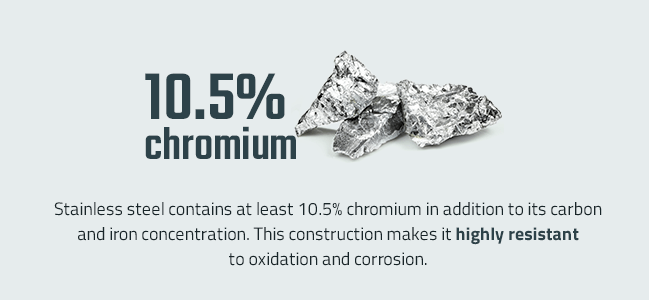
Pioneering Surface Treatments and Their Advantages
Besides the base material, manufacturers should also consider the type of coating carefully to ensure superior rust and corrosion protection. Below, we’ll review some of the best metal coatings for advanced corrosion resistance and the benefits that make them stand out for a given application.14
1. Copper
Copper has impressive malleability, electrical conductivity and corrosion resistance. These properties make copper both an excellent base metal and coating material. Copper is an effective coating for parts in a wide array of industries, including electronics, telecommunications and aerospace.15
2. Gold
Plating with gold provides numerous benefits, including better wear and tarnish resistance, solderability and low contact resistance. Gold is one of the least reactive metals, giving it inherent resistance to rust and corrosion. It also creates a heat-resistant barrier when applied as a plating, helping substrates withstand exposure to high temperatures, and is electrically conductive, making it suitable for electronics manufacturing.16
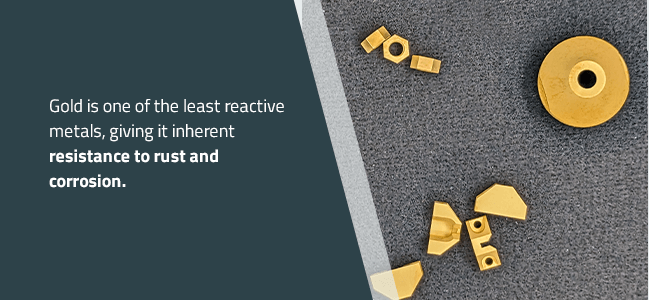
3. Electroless Nickel
Electroless nickel plating is ideal for manufacturing applications requiring17:
- Excellent corrosion, abrasion and wear resistance.
- Uniform coating thickness.
- High ductility and solderability.
- A bright finish.
4. Rhodium
Rhodium electroplating uses an electric current to apply a thin rhodium layer to a metal surface. This material is incredibly durable and boasts a highly reflective finish.18 These characteristics suit rhodium plating to a range of industries, including automotive, electronics and telecommunications.
5. Silver
Silver offers excellent thermal and electrical conductivity, allowing it to handle applications involving high heat and electricity.19 It’s also a more cost-effective alternative to other precious metals. Silver is an especially popular coating choice for aerospace, automotive and electronics applications.
6. Platinum
Though platinum has a high melting point, it is thermally stable.20 This feature makes it suitable for high-temperature environments like those common in aerospace, electricity generation and electronics. A platinum coating can provide excellent strength and longevity.
7. Palladium
Manufacturers often alloy palladium with nickel to improve its strength and solderability.21 It can also be paired with cobalt to increase electrical conductivity and durability. Electronics manufacturers often use palladium alloys to create contacts for printed circuit boards. Palladium is a common alternative to gold, serving many similar applications.
Coating Innovations for Superior Corrosion Resistance
We have covered the different types of corrosion, industry testing procedures and material selection tips. Now, how do you strengthen the corrosion resistance of metal 3D-printed coatings?
Manufacturers commonly use plating to apply a thin metal coating to the substrate. In addition to improved corrosion resistance, plating may provide many other benefits depending on the substance used, such as:
- Increased hardness.
- Reduced friction.
- Solderability.
- Bondability.
- Improved paint adhesion.
Embedding Corrosion Resistance Into 3D Print Design
During 3D-printed manufacturing, a machine creates a part or item with a digital three-dimensional design by depositing material in layers. This cost-effective, low-waste process is invaluable for testing new products and creating parts with complex features that would be cost-prohibitive to machine.
Like any metallic object, metal 3D-printed parts are vulnerable to corrosion depending on their composition. Plating these components reduces that risk and allows manufacturers to impart them with other valuable characteristics. When plated with the appropriate material, these parts can more effectively resist heat, chemicals, electromagnetic interference (EMI) and radiofrequency interference (RFI).22
Nickel plating, in particular, gives products exceptional strength and longevity due to its inherent corrosion resistance. Additionally, plating 3D-printed parts with a metal coating can provide lower contact resistance and higher stability while also enhancing their ability to withstand chemical exposure, wear and corrosion.23 For this reason, it’s wise to plan for plating application in the design phase to allow for any dimensional adjustments necessary to keep the part within established tolerances.
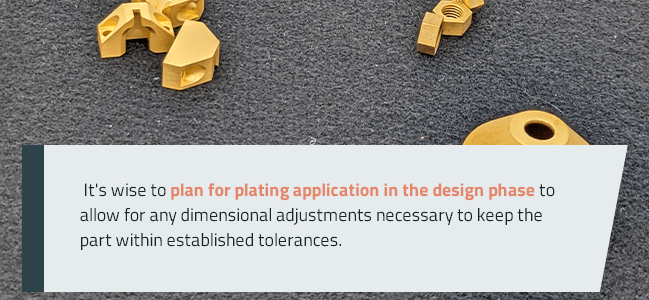
Pre-Processing
Cleaning and pre-processing is an essential step to a successful plating application that prevents corrosion in metal components.24 If the metal substrate is dirty, rusted and in poor condition, the coating will either fail to bond to its surface or encapsulate imperfections in the material and yield a poor surface finish. Thorough cleaning and sanitization remove debris and contaminants to prepare the part for plating.
During the cleaning phase, manufacturers typically start by soaking the workpiece in a cleaning agent to remove foreign materials from its surface. They then submerge the metal part in a hot alkaline cleaning solution.
Also called polishing, secondary surface cleaning eliminates any lingering soil or other contaminants missed during the precleaning stage. There are multiple secondary cleaning processes, including25:
- Abrasive blasting: This method uses pressurized abrasive media like aluminum oxide to scrub contaminants from the substrate.
- Ultrasonic washing: Ultrasonic washing involves immersing the substrate in an acidic-, alkaline-, detergent- or solvent-based cleaning solution and blasting it with ultrasonic waves to remove stubborn contamination.
- Spray cleaning: This technique applies chemicals with a spray nozzle to wash away surface debris.
- Pickling: Pickling submerges the metal substrate in a hydrochloric acid-based solution. It’s an effective method for removing rust, scale and inorganic contaminants, and it results in light surface etching that promotes better coating adherence.
- Electrolytic cleaning: During electrolytic cleaning, a manufacturer introduces a controlled DC electric current in an alkaline cleaning solution containing the metal substrate.
Post-Processing Steps for Enhanced Corrosion Resistance
Following the electroplating or electroless plating process, the metal substrate may undergo post-treatment steps for additional corrosion resistance. Passivation is a common post-treatment phase that applies a light protective material coating to the metal. This measure helps enhance the metal’s reactive properties and reduce the impact of environmental factors like air and water.26
When it comes to plating, manufacturers typically coat the surface with a metal oxide to slow the oxidation process, increasing corrosion protection. In some cases, the metal part may undergo heat treatment to prevent hydrogen embrittlement, a loss of ductility due to excess hydrogen exposure.27

Here are some other finishing processes that bolster corrosion resistance28:
- Cladding: Cladding combines heat and pressure to form a bond between the metal substrate and coating.
- Case hardening: Making the metal surface harder can help increase its corrosion resistance. Case hardening uses surface modification to accomplish this goal, hardening the outer layer of the metal to create a hard “case” more capable of resisting wear and other damage.
- Powder coating: Here, the manufacturer electrostatically deposits a dry powder onto the substrate’s surface rather than using a liquid coating. The metal part is then cured in an oven, stimulating a chemical reaction that creates a dense, thick protective coating that resists moisture, wear and impact.
- Buff polishing: Buff polishing doesn’t require any type of electrochemical reaction. Rather, a manufacturer uses superfine abrasives and a machine equipped with a cloth wheel to buff the metal surface to a high-grade finish. This process yields a glossy sheen for metallic products and provides a high degree of corrosion resistance.
- Vibratory finishing: Vibratory finishing helps remove rough edges and other irregularities from metal surfaces. The part is placed inside a tub or bowl containing abrasive media. The container is then activated to generate a vibratory action, causing the parts to rub against one another. Common vibratory finishing applications include descaling, edge-breaking, polishing and burnishing.
Overcoming Corrosion Hurdles in Metal 3D Printing
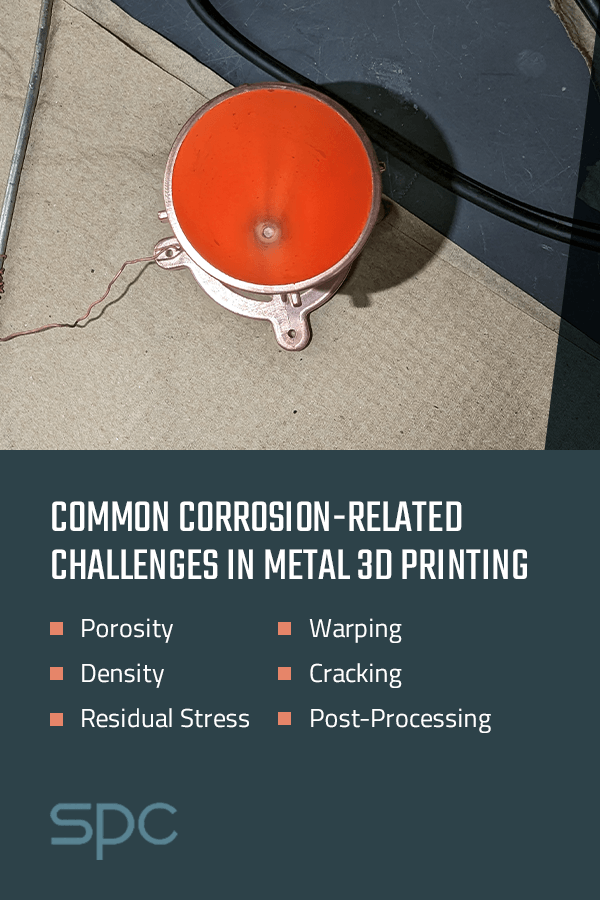
Here are some common corrosion-related challenges in metal 3D printing, along with some maintenance tips to prevent them.
1. Porosity
Pores can sometimes develop in the material during 3D metal printing.29 Porosity can result from an issue with the powder used during printing or complications with the 3D printing process itself. Excess or insufficient energy used during printing may result in pores in the material.
Regardless of the cause, these tiny holes can reduce the material’s density, potentially leading to issues like brittleness and cracking. Tuning your printer to meet the metal’s required parameters will mitigate this risk, as will using high-quality metal powder.
2. Density
Extreme porosity can lower density levels, compromising the material’s strength and potentially causing fatigue, wear and cracking under pressure. Improving the density of your metal components may require some trial and error, as multiple factors could be at play.
Assessing the quality of your metal powder is the first step to being able to adjust your process accordingly. You’ll want to optimize the material’s specific parameters, including particle shape, size, flow and distribution. For example, spherical particles can result in a more stable part since they achieve a higher relative density than other shapes and tend to flow smoothly.
3. Residual Stress
Residual stress results from heating, cooling, expansion and contraction during metal 3D printing.30 It’s one of the most common issues that arises during the process. Residual stress can significantly impact product quality and tensile strength, causing issues like warpage and cracking. You can minimize residual stress by:
- Preheating the printing bed correctly before the printing process.
- Meeting the metal’s required parameters like heat input and layer thickness.
4. Warping
When the substrate’s thermal stress exceeds the strength of its material, it can cause the part to warp.31 You can exercise the following measures to control warpage:
- Place the proper number of support structures in the correct locations.
- Clean the heated bed thoroughly after each use to remove debris.
5. Cracking
If the metal powder does not melt correctly, the material can crack. Contractions may also occur as the metal cools down, leading to deformation and fissures. A few solutions can help keep metal parts from fracturing:
- Use a heated bed and confirm it’s set to the proper temperature.
- Set your printer to a slightly slower printing speed.
6. Post-Processing Challenges
You may face some obstacles during post-processing. For instance, there may be complications in removing the support structures from printed metal parts. This is prevalent in metal parts with supports in small holes and tubes, as it can be challenging to remove these supports without causing damage.
Additionally, you might notice rough surfaces in metal components after processing. Surface roughness often results from improper powder melting due to inadequate energy being applied to the metal.32 In this instance, you can minimize surface roughness by increasing your laser’s power. Surface roughness can also correlate with layer thickness, so you can reduce this issue by printing with thinner layers.
Balancing Costs With Corrosion Resistance
A major benefit of 3D printing is that it’s less expensive than conventional manufacturing techniques and technology. You can reduce your staffing expenses since 3D printing is more automated. Additionally, 3D printing can lower costs because it generates less waste, resulting in lower material expenditures.
With the savings you may be able to realize from using this manufacturing technique, you can take advantage of top-tier coating technology to enhance your final product’s corrosion resistance and overall performance without overextending your budget.
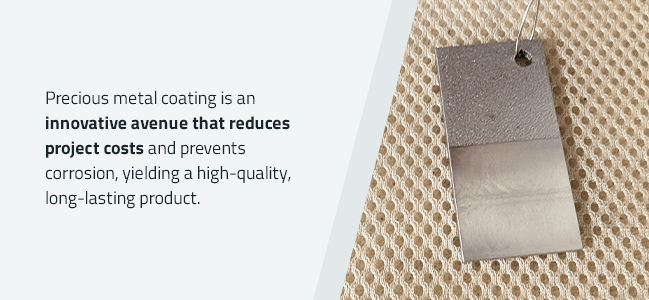
SPC’s Expert Role in Elevating Corrosion Resistance
Precious metal coating is an innovative avenue that reduces project costs and prevents corrosion, yielding a high-quality, long-lasting product.
Our experts will help you analyze the quality and condition of your substrate and make improvement suggestions accordingly. Our thorough pre- and post-processing measures ensure your final product is as contaminant-free and corrosion-resistant as possible.
We work with numerous substrates and coating materials, so we understand how each metal reacts with others and in various environments. Whatever your unique project and industry, we can work with you to select and apply the right plating materials for your requirements. View some of our testimonials to see how we’ve helped clients succeed.33
Learn More About SPC’s Corrosion-Resistant Plating Solutions Today
At SPC, we have decades of expertise in the plating industry, and we have refined our methods over time to deliver exceptional corrosion resistance, quality and performance. We offer plating services for 3D-printed base metals, parts and components.
Numerous steps go into creating a corrosion-resistant product, from selecting the right base and coating materials to administering proper testing protocols. At SPC, we handle this comprehensive process to ensure your final product meets and exceeds your expectations.
Our experts will meet with you for an on-site consultation to discuss your budget and other project requirements. We’ll answer any questions about the process and help you choose the best plating options based on your specifications.
SPC has the expertise necessary to reinforce the corrosion resistance of your metal 3D-printed enclosures and other components. To request a free, no-obligation quote or learn more about our precious metal coating services, fill out our form or call 717-767-6702 today.34
Sources:
- https://iieiug.weebly.com/uploads/2/6/3/6/26362706/50576-ch10.pdf
- https://researchrepository.wvu.edu/cgi/viewcontent.cgi?article=9164&context=etd
- http://www2.uwstout.edu/content/lib/thesis/2011/2011riedelp.pdf
- https://www.ampp.org/technical-research/what-is-corrosion/corrosion-terminology-glossary/corrosion-terminology-c
- http://www.mntap.umn.edu/industries/facility/machine/resources/platedright/particulatecontamination/
- https://www.semanticscholar.org/paper/A-Study-of-Various-Parameters-Affecting-Adhesion-of-Pathanatecha/0c41f0ce2c470acae6b2cc943e825e880a00659d
- https://www.copper.org/applications/rodbar/alloy360/alloy360.html
- https://www.mdpi.com/2076-3417/12/21/11285
- https://www.ampp.org/technical-research/impact/corrosion-basics/group-3/hydrogen-embrittlement
- https://www.nmfrc.org/pdf/psf00/jul67.pdf#page=2
- https://www.sciencedirect.com/topics/chemical-engineering/gold-plating
- https://link.springer.com/article/10.1007/s11814-011-0208-0




